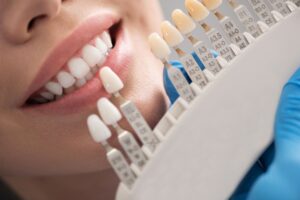
If you’ve ever had a severely decayed or damaged tooth, or recently underwent root canal therapy, you likely were fitted with a dental crown. These tooth-shaped caps are bonded over injured teeth to protect them and restore their functionality so that you can continue to eat and speak normally. This allows your dentist to preserve your smile in situations that might otherwise require an extraction.
Dental crowns can also boost your confidence because they’re customized to match the shape, size, and shade of your natural teeth. That way, no one will ever know you had a problematic tooth in the first place! But how does your dentist choose the right color? If you’re curious and want to know more, continue reading to find out!
What Color Are My Teeth?
To ensure that your restoration blends in seamlessly with the rest of your grin, your dentist acts as both a scientist and an artist. The outermost layer of your teeth, the enamel, is somewhat translucent and reflects light in a certain way. This can impact how the color is visually interpreted, which your provider takes into account when selecting the closest option. As a result, they consider a few different factors when seeking the correct shade, such as the:
- Hue. Most teeth have very distinct tones of gray, yellow, or red that must be matched.
- Value. This refers to how light or dark your teeth are.
- Chroma. This determines how densely saturated the pigment is.
How Is the Right Color Selected?
After your dentist establishes these values, they can find a suitable match for your dental crowns in a few ways, depending on the kind of technology they use. The most common methods are:
- A shade guide. This is the traditional method that utilizes a plastic or metal card that’s lined with artificial teeth with a variety of colors. Your dentist holds this up to your mouth to compare shades to find ones that most closely resemble your natural tone.
- Photographs. Some dentists prefer to take pictures and then digitally select a match based on images of your teeth from multiple angles.
- A spectrometer. This is a small electronic device that can be used to interpret color virtually.
Your dentist will likely select a couple of different possibilities and then gather your input on which option best suits your smile.
Once your restoration is created and bonded in place, you’ll have a perfectly restored tooth that looks and feels completely natural!
About the Author
Dr. Charles A. Parker has more than 40 years of experience enhancing people’s lives by improving their dental health. He earned his undergraduate degree from Baylor University and then his DDS from the University of Texas Health Science Center in San Antonio. Now, he offers a full range of services from two convenient locations equipped with state-of-the-art technology. Whether you need basic preventative care or a more complex procedure like dental crowns, he can help! You can request an appointment on the website or by calling (903) 935-6351.
 Request A Free Consultation
Request A Free Consultation
